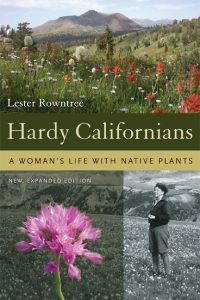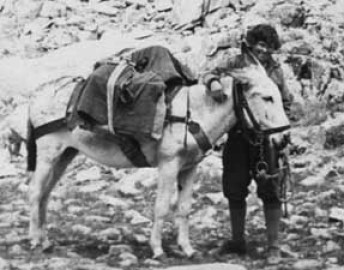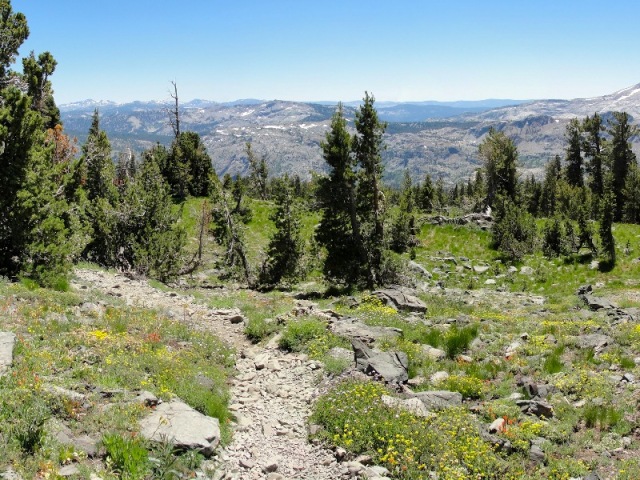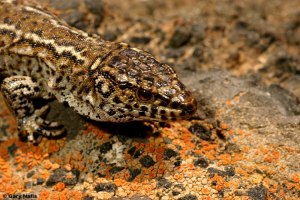Why do they do it? Not for fortune or fame–few outside native plant circles know who they are. People like Lester Rowntree, a plant explorer extraordinaire, who traveled the length and breadth of California to find and record the locations and characteristics of California native plants simply lived for this ‘doing.’
When’s the last time you thought about where the nursey plants you buy came from? I believe the real payoff is the thrill of discovery! I have felt this myself on my own land. Here’s the story of one fascinating woman.
Nellie Lester’s greatest joy as a child was to run away into the woods and collect plants, exploring for every new one she could find. After a traditional English-schooled teen age, but one during which she untraditionally ran away to be in the woods, she moved with her family from England to the US and ultimately California. Throughout, she develop a strong love of plant life, collecting and studying on her own.
She married Bernard Rowntree, an old family friend and after raising a son, she shed that life, divorcing, and at age 52 was suddenly free to become the person she was meant to be, Lester Rowntree*. That person was one who would begin traveling, alone in her car, drawn irresistibly to the tops of the California hills and mountains seeking out every plant she could find.
“It took adversity to bring me the sort of life I had always longed for,” she said.
After her divorce and ever with little financial means she sold her articles and she bartered with workman to build a small house in Carmel Valley where she kept a garden. This garden had to be relatively wild, as she’d leave it in February to start her plant and seed collecting trips.
“I inhabit my hillside only from November to February, while the winter storms are blowing and the winter rains pouring. In March and April I have long shining days in the desert, in May happy weeks in the foothills, where a chorus of robins wake me and my morning bath is in a rushing stream of just-melted snow. In June I am in the northern counties scented with new-mown hay and wild strawberries. In July in the higher mountains, and in August and September the alpine zone with mule or burro.”
Some compare her way of life to that of John Muir, but she differed from him in that she searched for the usefulness of the plants she found for home gardeners and was like him in the spirituality that kept her out in the wild, more comfortable there than among people.
“Up in the Sierra, after the flora and the fauna and the silva—the forest trees—have accepted you, you climb to the top of a peak in a thunderstorm, take off your clothes and dance in the rain. Soon you know that the elements have accepted you, too.”
She was a self-taught botanist, who kept her copy of Jepson’s ‘Manual of the Flowering Plants of California’ close by, writing her own notes in the margins. During her travels up and down the state, she wrote notes on Bank of Carmel deposit slips, just the right size, she commented, for a note or two on this plant or that. Once collected in a large envelope, these notes would turn into two books and countless magazine articles, which she wrote in order to finance a new car when she needed it, or to support herself in general.
“I soon found that there was more to the work than the actual collecting. In order to be properly thorough one should also be a trained botanist as well as an expert photographer as well as a gardener.”
(Even garden writers well know this.)
She would revel in sleeping under the stars and used her car, outfitted with only a driver’s seat, packed with books, supplies and portable writing desk, to get up to the places where she could go further on foot. She spent 9 months at a time, first in the desert, then in the mountains above San Francisco and lastly in the Sierras, following the seasons as the snow melted and she could travel higher to record the alpine plants of California. She had a seed business with a friend down in Carmel Valley where she built a small home, but it was her writing that kept her going.
She would sometimes put on her hat and stockings and descend down the mountain to give a talk to a garden club to support her next plant and seed collecting trek. She had a large correspondence and was well enough known amongst other plant collectors.
“By accident on the Grand Canyon’s north rim, she came upon fellow collector Rose Collum of Arizona, both crawling through the brush on hands and knees. Upon spying Lester, Collum said, ‘You must be Lester Rowntree!’ Lester stared back and said ‘You must be Rose Collum for nobody else would be such a nut!’”**
Her two books are ‘Hardy Californians: A Woman’s Life with Native Plants’ (1936), and ‘Flowering Shrubs of California and their Value to the Gardener’, (1939). The ‘Hardy Californians’, was totally updated by her grandchildren, with two biographical introductions, one by her grandsons and one written by Judith Larner Lowry. All the illustrations, photographs from Lester Rowntree’s large format negatives, have been updated in modern technique.
 Lester Rowntree wrote descriptively and with humor which was definitely not included in many books on botany. While on a trip to the Channel Islands, she wrote about how in the wild animals have few fears of humans and in particular how some lizards appreciated her singing.
Lester Rowntree wrote descriptively and with humor which was definitely not included in many books on botany. While on a trip to the Channel Islands, she wrote about how in the wild animals have few fears of humans and in particular how some lizards appreciated her singing.
“The lizard clan is diverse and fascinating,–also some members are very sentimental and love to be sung to. I found this out one day by chance when I was meandering about and singing to myself… As I sang, two very unlike specimens came out from under the stones. One…was over a foot long and incredibly beautiful with a bold tan armadillo-like design on his mustard yellow body. He resolutely advanced and together we sat on a rock. I stopped my noise and he made preparations to leave. I began it again and he stepped onto my knee. He showed an enormous capacity for large doses of song, closing his eyes in absurd abandon and opening them whenever I shut up, his eyelids sliding back to reveal pleading orbs. This went on for some time till I finally had to tell him that I must go about my business, and as I placed him, limp with emotion, on the boulder,…his reproachful eyes followed me on my way.”***
One of her pet peeves was the ever-growing population of grazing animals in the upper meadows and mountain slopes. She firmly begrudged them their feed, if they were the precious specimens she meant to study.
“Now I am not blind to the pictorial value of a handsome blue-jeaned Basque, staff in hand, perched on a gray granite boulder…. Nor am I averse to a hot, sizzling and succulent lamb chop, especially when I have just come in from the hills or the desert. But why can’t the sheep be given something else to eat but the very best of our wild flowers?”
In the last chapter of Hardy Californians, is this paragraph that says it all.
“It is said that native California plants are hard to grow. They are—so long as we insist on putting the wrong plant in the wrong place. Nothing can be more pig-headed than a Californian wild flower under uncongenial conditions, nothing so amenable and satisfying if happily placed.”
And this, about her explorations and discoveries, which seems to me a basic principle of growing California native plants:
“Surely some knowledge of a plant’s natural habitat may help a little toward finding for it the correct garden treatment.”
So what do you think of the life and lifestyle of Lester Rowntree? Can you imagine loving plants this much that you would take solitary trips, under terribly challenging conditions, in order the study and just be with them?
***
Notes:
While reading Hardy Californians, it is well to have Calphotos website open, too, in order to see the flowers to which she refers, many which may be unfamiliar, but if they were available, which is ultimately what she intended by writing this book, oh, what gardens could be possible! It makes native nursery owners all the more admirable if they offer challenging new varieties of California natives to the public, which may turn out to be excellent garden performers. The expanded version’s biographical additions tell wonderful stories that should bring joy to the native California plant lover.
*Lester Rowntree had taken her maiden name as her first name, in the custom of the school she attended once where the students called each other by surnames. Until they met, in answer to her letter’s W.L. Jepson, the famed botanist who founded the Sierra Club along with John Muir, would always refer to her as, “My Dear Mr. Rowntree.”
** Lester B Rowntree in ‘About Lester’, Hardy Californians
*** Hardy Californians, p. 17
All about Lester Rowntree– her grandson, Lester B Rowntree’s website.
Lester Rowntree’s classic 1936 book, “Hardy Californians” (Amazon), was republished in November 2006 by the University of California Press in a new, expanded format.
Lester Rowntree Native Plant Garden– The Carmel-by-the-Sea.. WATCHDOG!
Photos of the plants and lizard, WikipediaCommons
Photo of Lester Rowntree, Les Rowntree website











3 comments